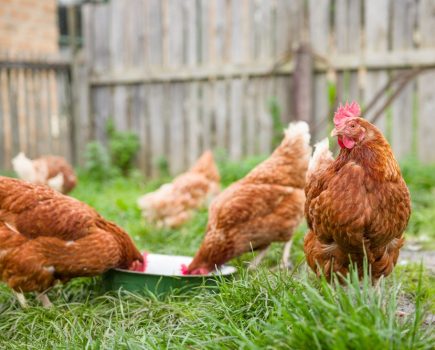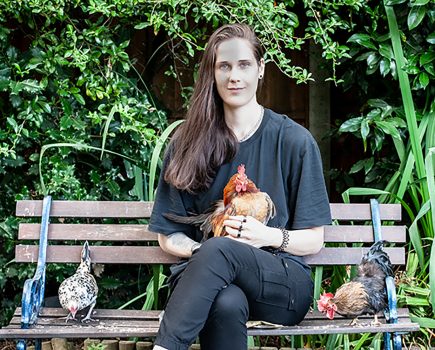Paul and Rebecca Howard, from Northamptonshire, have just started keeping chickens. Their experience is typical of many beginners. Here, Paul, a photographer, writes about the stages in their journey, and expert Andy Cawthray offers comments and advice
From taking photographs and writing stories about other people’s chickens to actually owning a couple of our own is a leap in the dark.
I am a freelance photographer and have been compiling stories and photos for Your Chickens over the past few years. I had never thought of becoming the proud owner of some hens myself until my wife Rebecca suggested having two in our back garden. She surfed the net, checking out how to go about having our first feathered friends.
Getting a coop
I went online to look for a secondhand coop and found one on eBay. I was about 30 miles away in Aylesbury. I put in my ‘best bid’ and watched the seconds tick down until that message flashed up saying I had won. I arranged to pick it up and went armed with a screwdriver so I could dismantle it and fit it in the back of my car.
Andy comments: One of the largest investments you make when starting out with chickens is likely to be the house. Whilst it is possible to grab a bargain, doing so carries risks. Cheap new housing is invariably poorly made using imported fast grown timber which will swell and split in our climate. So you can do as Paul did and trawl the adverts and auction sites to find a secondhand coop. Be very mindful, though, because by bringing in a used one you have added an ‘unknown’: it could contain disease or parasites. As a basic rule when starting out, budget to buy new; buy bigger than you need and buy to last.
Cleaning the coop
Once I got it home, Rebecca was on the case straightaway, disinfecting every nook and cranny with watered down Jeyes fluid. We realised it was not the best thing to use – the smell was very powerful! So, for the next week, we left the roof off and the doors and windows open. I then coated it with wood preservative (a pet safe variety) and made a floor for the enclosed ‘run’ from old pallets.
Andy says: Paul and Rebecca were right to perform a major clean of the secondhand coop as it could be carrying all manner of ‘nasties’. However, it would have been worth using a disinfectant cleaning product that is veterinarian or DEFRA approved. Products such as Virkon are excellent in this respect.
Paul was also right to treat the house with a pet safe wood preserver. Not only will it protect the investment but also helps in making the cracks less hospitable for parasites. As for the use of pallet wood, as long as it’s untreated it can prove an invaluable and very cheap material for the less house proud poultry keeper.
Getting some gear
So far we had only spent about £50 (£44 of that was the cost of the coop and run). Now we went to a local agricultural wholesaler and browsed all the lotions and potions for every aliment that a chicken could ever get! Initially we began to have second thoughts – we didn’t know all this might be necessary. However, a helpful sales lady said we really only needed a few basics to start with, such as red mite power to sprinkle in the coop, and lice powder. We also bought in bulk packs of dust extracted sawdust and wood chippings. The total now went up to around £75.
Andy says: I think it’s great when you meet an honest retailer who might well stock a massive range of products but is objective and offers sound advice. She was right: most of the potions and paraphernalia are not required when starting out with chickens.
Personally I use wood shavings as opposed to sawdust, and you should always make sure the shavings are hardwood and not bark. Ornamental bark of the type used on garden paths is cheap but can rot down quickly providing an excellent medium for aspergillus fungi to grow, and the spores can cause respiratory disorders in your chickens.
Getting some birds
They had a public noticeboard in the store and we put up a note asking if anyone had Pekin bantams for sale. A few days later a man phoned to say he supplied the local garden centre with their hens. We arranged to go over to his smallholding to view them. The supplier was very helpful, giving us lots of information and advice on what to have, and how to look after them. After about 30 minutes of intense ‘chicken talk’, we decided on a silver laced Wyandotte bantam (my choice) and a porcelain Pekin bantam (Rebecca’s choice). Afraid that the Wyandotte might fly over our garden fence, the supplier kindly (and gently) clipped her wing; he said the Pekin wouldn’t fly that high. It was cheaper to buy the hens from him than a garden centre and he offered to take them back and change them if we didn’t like them. He advised us to buy a 25kg sack of Diatomaceous Earth from eBay; he said he gives this to all his hens and it keeps worms at bay and is so much cheaper obtaining it this way (I later did as he suggested). We had brought along a box to transport our birds back home.
Andy says: There are very many suppliers of chickens and many sizes of operation. To say that one should only buy from ‘reputable sources’ is perhaps unfair on those small outfits that are equal, if not better, in terms of stock quality. It is, however, something to be careful about, especially if you have never assessed livestock before.
It sounds like Paul and Rebecca found a decent enough place; he offered a level of guarantee saying that if there were problems he would take the birds back.
Personally, I would always advise a minimum flock size of three birds; that way you reduce the risk of being left with a single bird should one die and avoid the issue of having to integrate it with new birds.
Settling in
On arriving home at 6.30pm I picked them up out of the box, the way that the supplier had shown me, holding my hands around their back and wings and then placed them in their coop. After bedding them down with sawdust and shredded paper, Rebecca put fresh water and layers pellets in the ‘run’ so that they had food and water for the next morning. We watched every move they made. By this time we had named them. We called the Pekin Queenie as she looks like she is wearing a Victorian bustle – I said she looked like Queen Victoria. We chose Lacey as she looks like she is dressed in lace.
Andy says: Paul and Rebecca made the right decision to place the birds straight into the house rather than letting them out into the run. It would have been worth putting the food and water in the house until the morning, though, if there was space.
I tend to find shredded paper doesn’t last very long as it quickly becomes soiled; better to just use wood shavings or an equivalent as coop litter and nesting material.
Free ranging
We were advised to keep them cooped up for about three days so that they would get to know that this was their house once they were let out. After two days we couldn’t wait any longer. Rebecca opened the run door and we expected a rush of bustles and feathers – but nothing happened. So it was time to coax. Rebecca tempted them out with some sweetcorn from a tin. Lacey was the first and then out waddled Queenie. It was lovely to see them exploring around the borders and gravel path. Oops! Lacey was heading straight up the path towards the garden gate, which I had judged too narrow for any chicken to squeeze through. Running up the path after her, I just managed to grab her backside (if that isn’t a chicken technical term, forgive me, as I am a novice!) just before she made a dash to even more freedom. That was my next job – staple more chicken wire to the gate.
Andy says: It’s a good idea to have the chickens associate the run with ‘treats’. That way you can coax them back to the house should you need to enclose them before dusk (which is when the chickens naturally roost). It was handy that Paul experienced a chicken’s natural curiosity so early on. Some chickens literally do push the boundaries to see how far they can roam.
Discovering their personalities
We had been told that hens have their own personalities, and it is true. Queenie really is the top dog and rules the roost, bossing Lacey about. We hope this might calm down as we don’t like to see Lacey literally left out in the rain on a wet day, as has been the case this week; Queenie sits in the doorway of the coop stopping her companion from entering. Now we have made a temporary shelter for Lacey in the garden. If anyone out there has any suggestions as to how you can make hens get on with each other, please let us know.
Andy says:
Ahh, the pecking order, or could it simply be dominance or aggression by the Pekin? It is another good example of why three birds would have been a better flock size to start with. It changes the flock dynamics and individual behaviours thus reducing the risks or instances of aggression or dominance between birds.
* We will visit Paul and Rebecca again later this year to see how they are getting on, and Andy will offer more advice.







